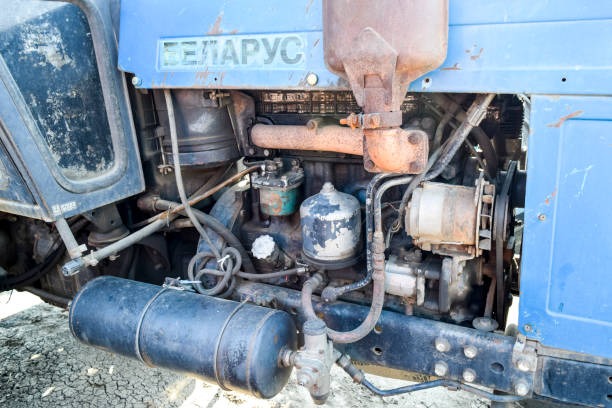Understanding Diesel Engine Power Flow
A diesel’s muscle is born in the combustion chamber where dense air and finely atomized fuel ignite under crushing pressure. The hot, expanding gases slam into the piston crown, transmitting force through rods and crank before meeting resistance in the drivetrain. Airflow dynamics dictate how evenly and aggressively combustion occurs; turbulent intake charge, precise swirl ratios, and optimal boost pressure create high-efficiency burn zones. Fuel atomization must be razor-sharp to fully exploit these pressure peaks. Exhaust scavenging clears residual gases quickly, preventing hot spots and incomplete cycles. Nail the airflow, injection timing, and exhaust purge, and every minor uptick upstream multiplies torque output downstream. Marginal gains here cascade into measurable real-world pulling power.
Optimizing Air Intake for Peak Diesel Efficiency
High-flow air filters widen breathing capacity but trade filtration density for volume. Cold-air setups draw denser intake charge, lowering combustion temperatures and often reducing EGTs under heavy load, while short-ram designs sacrifice cool density for throttle immediacy. Intake elbow sizing plays a pivotal role; narrower elbows spike velocity but risk turbulence, wider elbows smooth charge delivery yet increase pressure drop. Pressure-drop vs. flow-volume curves tell the story, revealing the diminishing returns of over-sizing. Precision selection of intake components can mean the difference between sustainable high-load operation and creeping heat soak during aggressive pulls. Skimp here, and you pay in temperature rise and premature wear.
Fine-Tuning Fuel Delivery for Consistent Power
A diesel thrives or chokes based on the integrity of its fuel delivery system. High-pressure pumps dictate both peak torque potential and stability under sustained loads. Single-stage pumps offer simplicity but can falter when fueling demands spike, while multi-stage designs maintain steady atomization in punishing conditions. Injector flow rates must match intended boost levels without over-fueling, which risks smoke and wasted energy. Nozzle spray pattern influences how completely fuel marries with the swirl in the cylinder; precision means fewer cold spots and more uniform pressure rise. Needle opening pressures determine how quickly injection begins under load, shaping torque curves you can feel in the seat.
Turbocharging Enhancements that Elevate Torque
Choosing between single scroll, twin scroll, and VGT configurations is a matter of airflow control and boost discipline. Single scrolls are quick to build pressure but may limit scavenging efficiency. Twin scrolls channel exhaust pulses with surgical timing, feeding the compressor more evenly. VGT units modulate vane positions, sharpening spool characteristics without spiking backpressure. The intercooler core must match turbo flow maps; too restrictive and you choke the charge, too loose and you leave density on the table. Compressor maps reveal sweet spots for efficiency at target RPMs. Spool time, pressure balance, and exhaust management form the holy trinity for sharp, repeatable torque gains.
Reinforcing Internal Components for Durability
Boosting power is pointless if internals fold under pressure. Forged pistons handle relentless thermal and mechanical pounding without deforming. Uprated connecting rods in 4340 chromoly shrug off shock loads that would snap stock units. Head studs keep sealing faces true even under cylinder pressures that climb past factory safety margins. Bearings built for high-load use resist fatigue where rotational inertia wants to grind them flat. Precision installation tolerances prevent micro-fractures and uneven load distribution. These upgrades aren’t glamour pieces—they’re insurance policies for engines living in the red zone. Ignore them and your performance investment becomes a short-lived spectacle.
Selecting Quality Components for Diesel Upgrades
Power gains stick only when built on parts that meet or exceed OEM tolerances. Verify metallurgy specs, dimensional precision, and documented load ratings for every upgrade. Fly-by-night suppliers can cost more in failures than the price of genuine kit. For consistent results under sustained loads, always source genuine diesel performance parts. Cross-reference with real-world dyno feedback before committing. Component synergy matters—each part should complement, not conflict with, the rest of the system. A mismatched upgrade is worse than no upgrade at all, undermining power balance and operational safety.
Integrating Electronic Tunes for Harmonized Performance
An ECU wielded correctly is a conductor ensuring turbo, injectors, and intake all play in tempo. Recalibration sharpens fuel maps, adjusts timing arrays, and sets hard limits to protect against thermal or mechanical runaway. Resistor-based modules offer rapid adjustments but lack the nuance of CAN-bus tuning, where real-time data drives changes. Datalogging reveals when components drift out of spec, enabling surgical corrections before failure. Fail-safes such as boost cutoffs and EGT alarms keep mechanical boundaries respected. Without harmonized tuning, even premium hardware performs like a choir out of sync—loud, but ultimately incoherent.
Maintenance Protocols to Protect Your Upgrades
High-output diesels eat through lubrication faster. Shorten oil change intervals to keep bearing surfaces pristine. Choose coolant formulas engineered to resist cavitation and scale in high-temperature blocks. Sensor accuracy is paramount; MAP, EGT, and fuel pressure data must be trusted for tuning and diagnostics. Predictive maintenance catches wear before it cripples performance—monitor component trends, not just catastrophic events. Ignore this layer and all upstream investment erodes quietly under neglect.
Crafting a Balanced Diesel Performance Package
Sequencing matters. Start with upgrades that support baseline longevity before chasing extreme boost levels. Intake and exhaust improvements often precede fuel and turbo changes, laying airflow groundwork so combustion gains are clean and controllable. Reinforced internals should be in place before tuning pushes cylinder pressures into the danger zone. Budget builds benefit from staged implementation, letting each change prove itself before stacking on complexity. For ultimate builds, every subsystem is selected as part of a cohesive architecture where airflow, fueling, pressure management, and electronic control work in lockstep. A balanced package doesn’t just make more power—it sustains it without compromise. When parts are chosen as a team, the engine stops being a sum of modifications and becomes a symphony of force.


